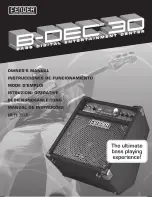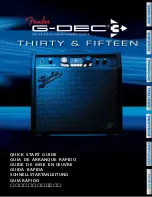
ENGLISH
15
A BEGINNER’S GUIDE TO EQUALISATION
Equalisers are also widely used in the audio industry, and are effectively just tone
controllers, though a bit more involved than those found on most hi-fi systems. They
allow you to cut or boost certain frequencies or frequency bands within the audio
signal.
There are two main applications for using equalisation, or EQ (as it’s more commonly
known). The first is ‘creative’ use. This involves enhancing a sound that is already
present in some desirable way. Typical examples might involve boosting lower
frequencies to give more depth, or boosting the high frequencies to give more of a
‘sparkle’ to a sound. Because the precise frequencies that give these qualities will vary
from instrument to instrument, it is sometimes necessary to be able to adjust the point
at which frequencies will be cut or boosted by the EQ, as well as the amount of cut or
boost.
The other main application of EQ is ‘corrective’ use. This involves using EQ to
remove or reduce the level of unwanted frequencies. Here are a few examples of
‘corrective’ use of EQ:
Cutting low frequencies to reduce ‘proximity effect’, where low frequencies have been
over-emphasised as a result of close miking with certain types of microphone.
Cutting the frequencies that may cause a vocal to sound boxy, nasal or harsh.
Cutting the frequencies that may cause a drum to ring undesirably.
Parametric EQ (such as the WARMTH control) allows the user to focus in on a
specific band of frequencies in order to cut or boost them. This is particularly useful for
‘corrective’ applications of EQ as the offending frequency may be honed in on, and its
gain reduced. It is also useful for ‘creative’ applications, for example giving warmth or
presence to a vocal.
Check out www.focusrite.com for links to more information on the subjects of
compression and EQ.
FREQUENTLY ASKED QUESTIONS
Q. Is the VoiceMaster Pro only suitable for recording vocals in musical
applications?
A. No, the VoiceMaster Pro is suitable for recording many other sound sources too,
such as electric guitars and bass (via its INSTRUMENT INPUT). It is also ideal for
applications such as recording the spoken word, live sound applications, radio and TV
broadcast, dubbing, post production and so on.
Q. Is the VoiceMaster Pro a Class A device, and why is that important?
A. Yes, the VoiceMaster Pro is a Class A device. Why? Class A is a type of amplifier
design in which you have standing DC current running through your amplifier circuits
all the time. As the signal comes along you vary what you're taking from that, rather
than switching between supplying a positive current for one half of the waveform and
a negative current for the other half. This results in the ability to represent audio in a
linear (distortion free) manner all the way through the circuit. Cheaper processors use
IC amplifiers which run close to Class B and don't have the same standing DC current,
which means the transistors inside the chips switch off and on, inevitably resulting in
less linear performance.
Q. My VoiceMaster Pro gets quite hot when in use. Should I be worried
about this?
A. No. This is a result of the high quality Class A circuitry inside your VoiceMaster
Pro, which has been designed to dissipate heat. As a precaution, it is wise to rack
hotter units lower down your rack than cooler units. If space is available, fit a blank
panel between units to allow extra ventilation.
Q. What is the difference b4 dBu and –10 dBV?
A. These are different signal operating levels. +4 dBu usually refers to professional
equipment and –10 dBV usually refers to semi-professional or consumer equipment. It
is important to make sure that any two or more devices connected to each other are
operating at the same signal level. If the +4 dBu output of a device feeds the –10 dBV
input of another device, this may cause the second device to overload. Alternatively, if
the –10 dBV output of a device feeds the +4 dBu input of another device, the second
device may receive a signal level which is too low (i.e. too quiet). -10 dBV devices are
usually connected using a mono 1/4” jack. This is known as an ‘unbalanced’
connection. +4 dBu devices are usually connected using a TRS (stereo) 1/4” jack, or
XLR. This is known as a ‘balanced’ connection.
Q. Should I use balanced connectors with my VoiceMaster Pro?
A. Yes, where possible. The line level analogue input is balanced, operating at +4 dBu.
The VoiceMaster Pro provides both balanced (+4 dBu) and unbalanced (-10 dBV)
output connectors. See the 'Rear panel connections' section on page 3 for more
information on connecting the analogue line level inputs and outputs.
Содержание VoiceMaster Pro
Страница 87: ...87 NOTES ...
Страница 88: ...88 NOTES ...
















































